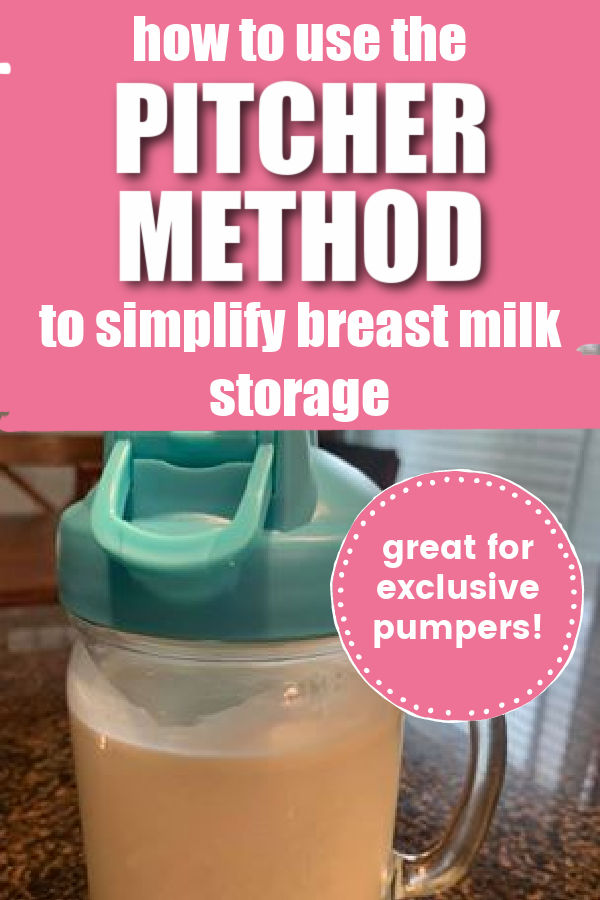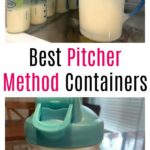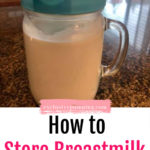Exclusively pumping results tons of baby bottles to store, keep track of, and wash. Many parents use the “pitcher method” – storing breast milk in a pitcher – as a way to simplify their daily pumping and feeding routine, and to make more room in their fridge.

This post may contain affiliate links, which means that if you click through and make a purchase, I’ll be compensated at no additional cost to you. I only recommend products I love! More info here.
What is the pitcher method?
Simply put, the pitcher method involves collecting all your pumped milk for one day and storing it in a large container.
At the end of the day – or whenever your container is full – you then prepare the next day’s feeding bottles using the milk collected. Any leftover milk can be put into breast milk storage bags and frozen.

Pros and cons to storing breast milk in a pitcher
Some people prefer to have a full day’s worth of bottles prepared at the start of the day. Others prefer to feed fresh milk as they pump it.
The pitcher method isn’t “better” than other ways of storing and feeding breast milk – the only reason to do it is if it makes life easier for you.
Here are some of the pros and cons.
Pros to the pitcher method
- Can simplify feeding and breast milk storage and make it more systematic – no wondering when each bottle expires or finding a 10 day old bottle in the back of the fridge.
- Using a pitcher rather than bottles can take up less space in your refrigerator.
- It helps make sure that any extra breast milk is frozen as soon as you know you don’t need it.
- Some people with foremilk/hindmilk imbalance find that it helps keep the milk that’s fed to baby more balanced.
Cons of the pitcher method
- If your container is accidentally dropped or broken, you will lose all of the breast milk that you had stored in it.
- Sterilizing the pitcher may be challenging depending on the size of it and whether or not you have a dishwasher.
What container should you use for the pitcher method?
Some of the features you want to look for in the container include:
- Ability to hold between 28-64 ounces (you want it to be able to hold more than you normally pump in a day)
- An easy pour spout, so that you don’t lose any milk when transferring it to bottles
- A lid to protect the milk when it’s stored in the refrigerator
- Made from glass or food grade plastic
Some great options that moms in our Facebook group have used include:
1. Dr Brown’s Formula Mixing Pitcher
is one of the most popular choices for storing breast milk. It holds 32oz, and you have the ability to mix the milk using the blade.


2. Rubbermaid MixerMate
The MixerMate holds 32oz of breast milk and has a secure top with a spout for pouring.
3. Mason Jar
One benefit of using a mason jar is that the fat from breast milk tends to stick less to glass containers. These tops provide an airtight seal and easy pour spout for mason jars.

 4. Shaker Blender Bottles
4. Shaker Blender Bottles
This shaker bottle by Blender Bottle holds 28oz of liquid.
Tips for storing breast milk in a pitcher

Here are some ways to make sure you handle your breast milk safely (and don’t waste any!) when using the pitcher method.
Cool milk before combining
When mixing milk from multiple pumping sessions, it is recommended that the milk always be the same temperature.
Always cool freshly pumped milk first so that you are not mixing cold and warm milk together. (I suggest putting bottles of freshly pumped milk in the fridge, and then dumping them in the pitcher after your next pumping session a few hours later.)
More on mixing breast milk from different days and sessions here.
If more than one day’s milk is in the pitcher, label with first expressed
If your container has more than milk from more than one day in it, label your container with the date of the oldest milk. You need to treat all of the milk in the pitcher as if it was pumped on that first day.
Breast milk can be stored for up to 4 days in the refrigerator.
Mix the milk together
Fully incorporate the fat by swirling the container
so that your milk is well balanced.
You may want to use a silicone spatula to scrape off any fat stuck to the sides of your container.
Sterilizing the container
Like your bottles and pump parts, your pitcher should be washed according to CDC guidelines and sterilized on a regular basis.
Sterilizing can be challenging if your container is too large to fit in your sterilizer or whatever method you use to sanitize. If you have a dishwasher, that’s probably the easiest way to do it. Medela Quick Clean Sanitizer Spray might be another option.
Have you tried storing breast milk in a pitcher? Tell us your experience in the comments!
References- Bonyata, Kelly, IBCLC. “Breastmilk Storage & Handling.” https://kellymom.com/bf/pumpingmoms/milkstorage/milkstorage/

























